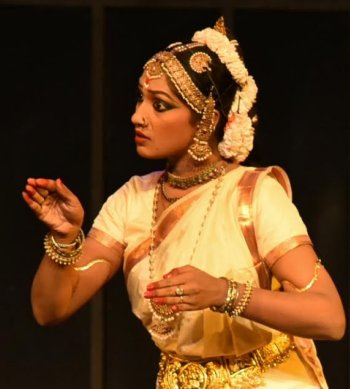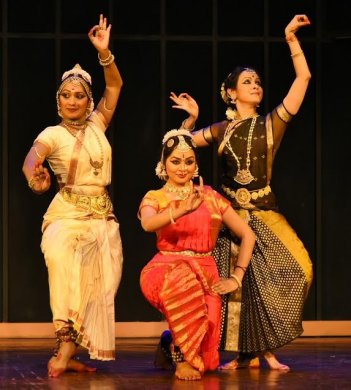
|   |

|   |
Dances on divya vahana - Shveta Arora e-mail: shwetananoop@gmail.com Photos: Anoop Arora December 18, 2016 On a pleasant evening in November in Delhi, the Sadguru Sri Thyagabrahma Aradhana Kainkarya Trust conferred the Nataraja Samman on dancers who have excelled in their field - Rama Vaidyanathan (Bharatanatyam), Gopika Varma (Mohiniattam), Deepika Reddy (Kuchipudi) and Rajendra Gangani (Kathak). The performances for that evening were on the theme of Divya Vahana, part of a trilogy, the first being Divya Astra. The event was conceptualized by Usha RK and held at IHC in Delhi. A vahana means a vehicle of the Lord. It is mostly an animal or a mythical entity; each vahana has its attributes and a tale to relate it to the deity it is associated with. The relationship is often reciprocal, and the vahana represents certain qualities which complement the deity. Garuda is the large mythical eagle and the mount of Lord Vishnu. It was presented by Shivaranjani Harish in Bharatanatyam. She wore a golden yellow saree for the piece, which was appropriate for garuda. She started the presentation with a garuda kauthuvam. He is the son of Vinathi and Kashyap and wears the snakes Adishesha, Vasuki, Gulika as his adornments. The tale has it that Garuda flies to Indralok to get the pot of amrita to free his mother from the slavery of his snakes. His courage during his fight with Indra and the snakes impresses Lord Vishnu, who then takes him as his steed. Shivaranjani’s depiction of the rounded sharp beak and large wings with leaps and apt movements was impressive, especially the stretched one-legged stance of the garuda in flight. Svarnakaye (golden-bodied), shvetavarna (white-faced), pakshidhara mahamati vahana gaganeshwar (lord of the skies, the biggest bird), vishnurath (the steed of Vishnu), Adishesha as his adornment, Vasuki his yagyopaveet (sacred thread), veeraputra, anupamteja were the attributes depicted. The imagery and abhinaya were all skillfully rendered. The choreography was by Guru Kiran Subramaniam, lyrics and music by D Srivatsa.  Shivaranjani Harish  Arupa Lahiry The dancer portraying Gaja was Arupa Lahiry, a disciple of Chitra Visweswaran. Here, the elephant is not the steed of Goddess Gajalakshmi, but she is seated on a lotus with elephants on all four sides pouring water on her as an abhishekam. Mahalakshmi was incarnated out of the churning of the ocean surrounded by her four elephants. In 5th and 6th century murals, she is depicted as washing her hair with this water, and the droplets fall on the swans who are pure souls. Arupa entered the stage holding one hand like the elephant’s ear and the other raised as the trunk. The jathis and movements were measured and flowed smoothly. The movement for the waving of the ears was wide and jerky, to depict their flapping. Lakshmi is worshipped as the durgativinashini, phal pradayini (removes obstacles and gives the fruit of prayers). The Trinity (Hari, Hara, Brahma) worship her. Arupa depicted her as emerging from the Ksheera sagar with the four gajas pouring water on her from their trunks. As Arupa showed the loosening of her hair and washing them in the water, the lights were dimmed and the vision of the beautiful goddess washing her hair had a touch of magic. The next vahana depicted was the hamsa, the vehicle of Goddess Saraswati. The swan symbolizes knowledge and self-realization and lives in the Manasarovar lake near Mt Kailash. The white colour is the symbol of excellence. T Reddi Lakshmi, a disciple of Jayarama Rao, clad in a white sari, explored the format of pravesha daruvu. The bird is born from the beejakshara. She is pained and looking for the purpose of her life, and is drawn to Goddess Saraswati through the music of her veena. The gait of the swan and the flying motion were apt. Goddess Saraswati is described as mata gyananetra pradata – she is the one who gives the eye for knowledge. The performance ended with the chant ‘Soham.’  T Reddi Lakshmi  Reddi Lakshmi, Shivaranjani, Arupa Nandi, the steed of Shiva, was depicted by Shivaranjani again in a red sari. Nandi is famous for his mastery over rhythm and accompanies Shiva on the mridangam during the celestial dance. The piece began with a shlokam on Nandi, followed by a Nandi chol. Here, the piece finally reaches a crescendo with the word ‘Nan-di’. Shivaranjani could capture the gait of a bull in her dance. In a Shiva temple, Nandi sits right in front of the Shiva lingam. A bhakta Nandanar who has come for darshan of the lord could not see him because of Nandi sitting in front. So he requests the bull to move a little. But Nandi does not budge, and it is only after Shiva pleads with him that Nandi moves just a bit, proclaiming, ‘I may have moved, but I am still his first devotee.’ The depiction of the piece was done with flair and a touch of humor. Shivaranjini would, each time, kneel and slump backwards to show the stubborn Nandi. The condescending attitude of Nandi when he moves a little to allow a view of the lord was also expressively portrayed. The musicians for the evening were Srivatsa on vocals, Ramya Janakiraman on nattuvangam, Saraswati Rajagopalan on veena, Sreedhar on violin and Rajat Prasanna on flute. Shveta Arora is a blogger based in Delhi. She writes about cultural events in the capital. |